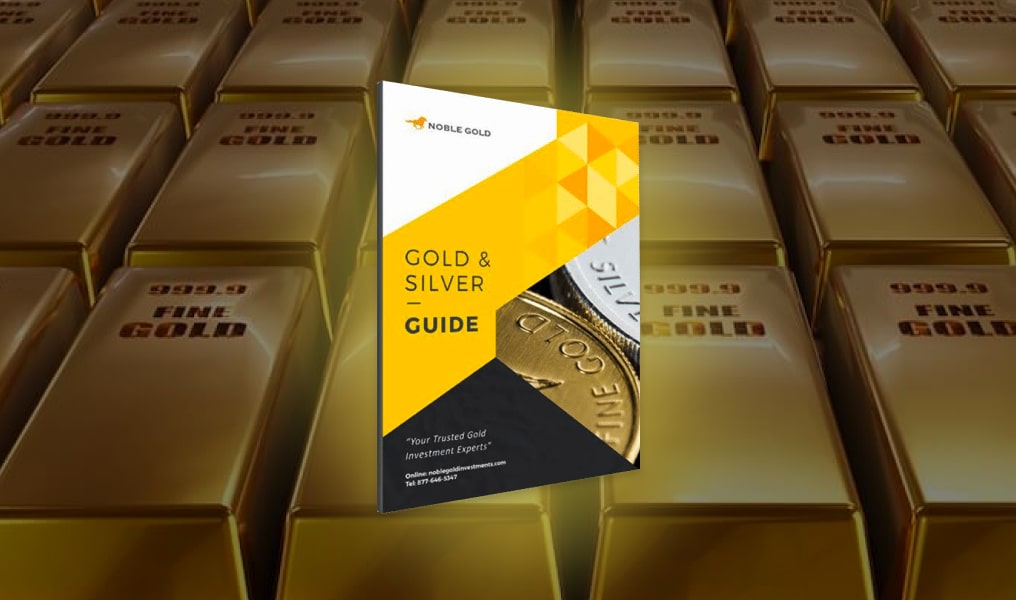During the Inflation Crisis of the 1970s, silver prices skyrocketed by more than 400%. Investors who paid attention to silver price trends and how inflation affects them could have seen it coming. Today, fifty years later, you’ll have the insight to make more timely buys by watching these same trends.
What Is the Price of Silver?
Silver is one of the most sought-after precious metals for investors across the globe. You can buy and sell silver in various forms (coins, bars, rounds, etc.), sizes, and price ranges. Before investing in silver, you’ll want to understand how silver prices work.
When we refer to the price of silver, we’ll often use the term “spot price,” which is the amount you can exchange and deliver your investment for right now: the current trade price.
The exchange rate for precious metals constantly fluctuates, never staying at the same number for long. If you looked at the silver spot price yesterday, recheck it today. Exchange rates shift every few minutes as investors make purchases and sales worldwide.
How is the price determined?
Investors buy and sell silver using exchanges like New York, London, Zurich, and Hong Kong. However, the most prominent exchange in the silver business is COMEX, which stands for The Commodity Exchange Inc. COMEX leads the way in determining silver prices.
COMEX calculates the spot price of silver using the front month’s futures contract with the most volume. Futures contracts are deals in which the buyer agrees to purchase a set amount of silver at a fixed price on a specific future date. Either party could make a profit, depending on how the market fluctuates.
Silver spot prices change continuously, rarely staying the same for long. Factors that contribute to this constant fluctuation include:
- Silver demand and supply
- Currency fluctuations
- Silver scrap
- Inflation
- Geopolitical conflict
- Gold prices
- Interest rates
- Asset allocations
Price Trends
Although exchange rates go up and down seemingly randomly, you can learn much from looking at silver price trends. Historical price trends help you see the big picture and show you what to expect five, 10, or 15 years from now. If you want to invest immediately, you’ll want to pay attention to current price trends to understand the best buying time.
Historic Price Trends
On January 21, 1980, silver prices reached a record-high $52.50 per ounce (equivalent to $165 per ounce, considering inflation). The current spot price is much lower than that number today at $18.45. However, recent trends show that silver prices have risen over the past five years, reaching nearly $30 per ounce in May 2021.
End of 2022 Trends
Since January 2022, the price of silver has steadily declined. Many analysts believe this downward trajectory will continue until the end of the year, making silver relatively cheap and less risky for first-time investors. At first, dipping spot prices seem negative, but this trend could lead to a silver market boom after 2022.
Beyond 2022 Trends
Predicting the future of silver price trends is impossible—not even the experts can guarantee future returns based on previous trends. However, if the price continues to decrease, we could see the market rebound, investment demands go up, and spot prices steadily rise over the next few years.
Two factors may contribute to a soon-coming spike in silver prices: rising interest rates and an overheated stock market. Rising interest rates spell problems for the economy, and that’s when many people turn to more stable markets like silver. Silver investments may also increase as investors find ways to protect themselves against an overheated, volatile stock market.
What Could Cause the Price of Silver to Reach $100 or Higher?
At the current price of $18.45 per ounce, silver prices would have to increase by more than 500% to reach $100 or higher. Some investors and analysts believe it could happen. Many national and global trends we’re seeing today could cause silver to attain historic heights down the road, including:
Demand for Green Energy
As the global demand for green energy increases, so will the demand for silver. Green initiatives like solar power and renewable energy rely on precious metals to improve our ecosystem and combat climate change. Three emerging industries could cause a silver boom.
1. Solar Photovoltaic Panels
Solar panels depend heavily on silver because of the element’s high electrical and thermal conductivity. With a recent surge in polysilicon production (an essential component of solar photovoltaic panels), we’ll likely also see a spike in silver investments.
2. Consumer Electronics With Remote Work
During the COVID-19 pandemic, many employees switched to remote work amid lockdowns and quarantine. Remote work quickly became the new normal and is still an excellent alternative to going to the office in person. The hardships of the past two years shook the business world and resulted in an explosion of remote employment opportunities.
With an uptick in remote work, electronics companies witnessed an uptick in consumer sales. Every work-from-home employee needs a reliable laptop, mobile phone, and other electronic devices. With silver being a key component in manufacturing electronics, the electronics industry directly affects the silver industry and its prices.
3. 5G Technologies
Technologies like 5G are rising, and many investors continue to support its infrastructure. Silver is a critical component in 5G technologies, as with other electronics. The more 5G technologies increase, the more companies invest in silver, and the higher the prices will likely increase.
This isn’t a guarantee, however.
As technology advances, silver may become less and less necessary. For example, stainless steel has replaced silver in many household items, such as forks, spoons, and knives. Changes in how products are produced occur constantly, and technological inventions could soon no longer require silver as a critical component.
Inflation in the U.S.
Inflation is one of the most prominent determining factors in silver spot prices. It’s not hard to recognize a correlation between inflation trends and silver exchange rate trends. As inflation steadily increases in the U.S., silver prices will likely increase, too.
How does inflation affect silver prices? Inflation erodes the dollar’s value, leaving paper-money millionaires less wealthy than before. Silver, on the other hand, is more stable and can protect investors against economic crises.
In the 1970s, the United States faced the so-called Inflation Crisis, during which silver prices suddenly spiked. Spot prices jumped from $12.40 per ounce to nearly $50 in a decade—an increase of over 400%. We’d need a 500% increase to reach $100 per ounce, but history shows that this scenario isn’t out of the question.
We could face an Inflation Crisis 2.0, where silver prices would skyrocket. If inflation rates keep swelling and other factors line up, silver might increase to $100 per ounce.
Mining Supply Issues
During the pandemic, silver demands continued to increase. However, many employers had to let workers go or have employees work from home, leaving a gaping hole in the mining industry. Silver mines reduced production, and some shut down production indefinitely.
With any market, the prices go up when the supply can’t meet the demand. Many mines still struggle to produce and transport sufficient amounts of silver, creating a logjam in the supply process. If mining supply issues last another few years, silver spot prices could rise significantly.
Silver Scraps
Another factor that could cause silver prices to reach $100 or higher is silver scraps. It used to take large quantities of silver to make good photographs, but those days have passed. Now, we have gobs of old photographic silver scraps to recycle and reuse.
With such a high demand for silver, recycling silver may become a big part of the precious metal industry. The value of silver scraps could increase, causing silver prices to climb.
Interest Rates
To understand how silver price trends work, it’s important to study interest rate trends. As inflation in the U.S. rises and the national debt continues to increase, we’ll likely face steep interest rates in the next couple of years. Investors often turn to silver investments on these occasions to protect their assets and have more purchasing power.
Low Gold-to-Silver Ratio
When we talk about the gold-to-silver ratio, we’re referring to how much silver it takes to buy an ounce of gold. Silver prices typically follow gold prices, which means the current price of gold often determines the value of silver. Following the gold-to-silver ratio can help you determine future silver spot prices and make wise investments.
High gold-silver ratios indicate that silver is less valuable than gold, while lower ratios mean silver has more value. Currently, the gold-to-silver ratio is low. If it keeps getting lower, we’ll see the value of silver continue to increase.
Stock Market Uncertainty
History shows that the stock market’s reliability or volatility impacts silver prices. When investors grow uncertain about the stock market, they typically diversify their investments and look to the silver market.
In December 2021, stock indexes reached a record high. But the numbers went down during the next couple of months, leaving people with doubts and misgivings. You’ll want to keep an eye on the stock market as drastic fluctuations could lead to sharp increases in silver prices.
Current World Events
In the past, geopolitical unrest has caused silver prices to go up. International conflicts have massive effects on national and global economies. We often see inflation and debt increase during conflicts like war, making fiat currency less valuable and silver more precious.
What’s going on in the world today will affect silver prices. Two current world events could cause silver prices to skyrocket:
- Russia-Ukraine conflict. Russia supplies 2.6% of the world’s silver. However, Russia’s war with Ukraine has cut off that silver supply to the United States. As a result, we can expect silver prices to rise.
- China-Taiwan conflict. The tension between China and Taiwan could significantly impact international affairs and the global economy. If this happens, we’ll likely see a rapid increase in silver prices per ounce.
Silver Price Chart Reading
Silver price charts are helpful tools to show you the current spot price. The exchange rate changes almost every second, and these charts keep you in the know with real-time updates. In addition, price charts can show data and pricing trends over the past 20 years.
Why Use a Chart?
Price charts give you an incredible amount of detailed information on the current silver market. You’ll want to utilize these charts as you try to identify silver price trends.
Historical data on silver prices can help you recognize current price trends. Seeing what happened in the past often gives you insight into what could happen in the future. You can also look at daily data to identify which direction silver prices are going.
How Do You Read a Chart?
Silver price charts are pretty simple to read and present clear information. The trick is interpreting data accurately to know the best time to buy and sell silver.
When reading a chart, you’ll want to look for a few things:
- Historical trends
- Series of highs and lows
- Pullbacks in silver prices
- Triangles
- Wedges
- Head and shoulders
- Double bottoms
Is Silver a Good Investment?
Many first-time investors wonder if silver investments are worth the effort. The short answer is yes. The long answer is that silver investments offer several benefits both now and later, including:
- Diversifying your savings with a defensive asset
- Protecting your finances against economic crises
- Saving on taxes
With an Individual Retirement Account (IRA), you can make the most of your silver investment. Silver IRAs allow you to hold the silver in physical form and enjoy not having to pay taxes on it. Your silver coins and bars are safe in an IRA!
Invest In A Silver-Backed IRA With SpaceXgold
It’s impossible to predict the future. Price trends rise and fall without warning, but one thing is sure: precious metals are here to stay. Silver has been around for centuries, and while it’s no longer used as currency, its value has never dwindled.
Inflation rates are at an all-time high for the first time in decades and what history has shown us is that when inflation rates skyrocket, people hold onto their silver and see investment prices increase. If you’re watching silver price trends and want to invest in a Silver IRA before the boom, contact one of our experts today by calling ..
At SpaceXgold, we help people make the most of their gold and silver investments with a gold & silver IRA. Let us help you save for the future; your future self will thank you.






